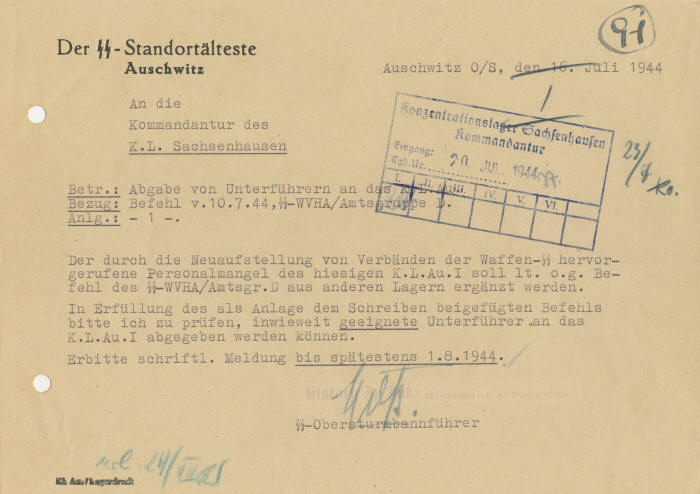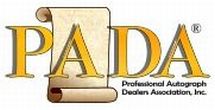2121502
Rudolf Höss
Scroll down to see images of the item below the description
Extremely rare letter by Höss, the Commandant at Auschwitz,
requesting the assignment of more staff officers for the infamous Nazi extermination camp
Rudolf Franz Ferdinand Höss (German, Höß; Anglicized, Hoess), 1901–1947. Nazi German SS-Obersturmbannführer (Lieutenant Colonel); Commandant, Auschwitz-Birkenau Concentration Camp, 1940–1943, 1944–1945. Typed letter signed, Höss, one page, 8¼” x 5⅞”, on stationery of Der SS-Standortälteste [Garrison Commnander] / Auschwitz, Auschwitz, Upper Silesia, July 16, 1944. In German, with translation.
The autograph material of Höss is among the rarest of the German Third Reich. This letter is one that collectors of Third Reich material should not let pass by.
Höss, the longest-serving commandant of the notorious Nazi extermination camp at Auschwitz-Birkenau, in Poland, refined and expedited the systematic extermination of European Jews in what the Nazi German government declared to be “the final solution to the Jewish question.” It was Höss—not to be confused with Rudolf Hess—who implemented the use of Zyklon B, a pesticide containing hydrogen cyanide, to exterminate approximately 2,500,000 Jews in gas chambers disguised as delousing showers at Auschwitz, which became the symbol of the Holocaust.
In this extremely rare wartime letter, Höss requests the transfer of additional non-commissioned officers from the Sachsenhausen concentration camp to Auschwitz, presumably to oversee or assist with the accelerated extermination of Jews as Nazi Germany felt the pressure of Allied advances. Just over five weeks earlier, Allied forces launched the D-Day invasion of Normandy, and by mid-July, when Höss wrote this letter, American and British forces controlled the Cotentin Peninsula and some 25 miles inland from the landing beaches, including the cities of Caen and Saint-Lô. In the east, in Operation Bagration, Soviet forces had pushed into central Poland on their way to Berlin.
Writing to SS-Standartenfuhrer (Colonel) Anton Kaindl (1902–1948), the commandant at Sachsenhausen, Höss says, in full:
Regarding: Transfer of noncommissioned officers to the Auschwitz Concentration Camp
Reference: Order of October 7, 1944, SS Chief Economic and Administration Main Office / Official Group D
Enclosure: - 1 -
According to the above-referenced order of the SS Chief Economic and Administration Main Office, Official Group D, the staff shortages of the Auschwitz I Concentration Camp here caused by the realignment of the Waffen-SS shall be supplemented from other camps.
In compliance with the order annexed to this letter, I ask you please to examine the extent to which suitable noncommissioned officers can be transferred to the Auschwitz I Concentration Camp.
Request written notification by August 1, 1944, at the latest.
“The ‘final solution’ of the Jewish question,” Höss wrote, “meant the complete extermination of all Jews in Europe.” According to Höss, Heinrich Himmler, the head of the Nazi SS, told him that Nazi Führer Adolf Hitler had “ordered the solution of the Jewish question in Europe.” The “final solution” was formalized in January 1942 at the Wannsee Conference outside of Berlin led by SS-Obergruppenführer Reinhard Heydrich, the head of the Reich Main Security Office, at the direction of Nazi Reichsmarschall Hermann Göring. But even before the conference, Höss said, he “was ordered to establish extermination facilities at Auschwitz in June 1941.” So, he said, “Mass executions by gassing commenced during the summer 1941 and continued until fall 1944.” Auschwitz I, which Höss mentions here, was the main camp at Auschwitz-Birkenau.
Höss estimated that during his first assignment as the commandant of Auschwitz between May 1, 1940, and December 1, 1943, “at least 2,500,000 victims were executed and exterminated there by gassing and burning, and at least another half million succumbed to starvation and disease, making a total dead of about 3,000,000.” The victims, he said, included “about 100,000 German Jews, and great numbers of citizens (mostly Jewish) from Holland, France, Belgium, Poland, Hungary, Czechoslovakia, Greece, or other countries.” Höss returned to Auschwitz on May 8, 1944, to oversee the extermination of Hungarian Jews under the code name “Aktion Höss.” During the summer of 1944, he said, the Nazis “executed about 400,000 Hungarian Jews alone at Auschwitz.” Through the end of the summer, trains transporting Jews from European countries under German control arrived almost daily at Auschwitz-Birkenau. The gassing operation continued until November 1944.
The Nazi atrocities were beyond words. In an affidavit that he signed in connection with the Nuremberg War Crimes Trials in 1946, Höss explained the system that he installed for the execution of Jews at Auschwitz:
So when I set up the extermination building at Auschwitz, I used Cyclon B, which was a crystallized Prussic Acid which we dropped into the death chamber from a small opening. It took from 3 to 15 minutes to kill the people in the death chamber depending upon climatic conditions. We knew when the people were dead because their screaming stopped. We usually waited about one-half hour before we opened the doors and removed the bodies. After the bodies were removed our special commandos took off the rings and extracted the gold from the teeth of the corpses. . . . The way we selected our victims was as follows: We had two SS doctors on duty at Auschwitz to examine the incoming transports of prisoners. The prisoners would be marched by one of the doctors who would make spot decisions as they walked by. Those who were fit for work were sent into the Camp. Others were sent immediately to the extermination plants. Children of tender years were invariably exterminated since by reason of their youth they were unable to work. . . . [A]t Auschwitz we endeavored to fool the victims into thinking that they were to go through a delousing process. Of course, frequently they realized our true intentions and we sometimes had riots and difficulties due to that fact. Very frequently women would hide their children under the clothes but of course when we found them we would send the children in to be exterminated. We were required to carry out these exterminations in secrecy but of course the foul and nauseating stench from the continuous burning of bodies permeated the entire area and all of the people living in the surrounding communities knew that exterminations were going on at Auschwitz.
Höss would hang for his crimes. Urged by Himmler to hide, Höss worked on a farm near Flesnsburg, on the German-Danish border, for
some ten months until he was arrested by the British on March 11, 1946, disguised as a gardener
under the assumed name Franz Lang. Three weeks later, he was
transferred to Nuremburg, where he testified candidly in the War Crimes Trials,
contradicting Nazi Reichmarschall Hermann Göring’s claim that
there was never an order for mass destruction of the Jews. He was then
handed over to the Poles, since his crimes occurred in Poland. After a
three-week trial in which he acknowledged his “full responsibility as camp commandant” for
what had happened at Auschwitz, he was found guilty and sentenced to death.
He was hanged at Auschwitz on the site of the camp’s Gestapo headquarters.
This piece shares an interesting, if unintentional, association with
Höss has signed in blue fountain pen.
The printed note in the lower left corner shows that this stationery shows
that it was printed at the Auschwitz Concentration Camp. The letter
has markings in ink and indelible pencil that are typical of the time,
including one showing that the Sachsenhausen commandant replied to
Höss on July 24, 1944.
This piece is in very fine condition.
Only typical file holes
in the blank left margin keep it from being extra fine.
We reject Nazism and all that it represented.
Yet the German Third Reich and the Holocaust that it systematically carried
out played an undeniable role in 20th
Century history. This extremely rare letter illustrates how focused the Nazis
were on
pursuing their
scheme against the Jews. Since we believe that to decline to
offer Third Reich material, although it is offensive, would aid those who
want to sweep the Third Reich under the rug and deny that the Holocaust
occurred, we offer this material because the world must never forget what
happened, lest it happen again. As Winston Churchill said,
paraphrasing the Spanish philosopher George Santayana, those who fail to
learn from history are doomed to repeat it.
Unframed.
To the extent applicable to those affected by German law, particularly § 86a StGB, historical and military items from or relating to the period and personalities of the German Third Reich are offered for only purposes of education and research regarding
historical events and military history and uniforms. Clients who purchase such items agree that they will not use them for propaganda or other purposes that would be punishable under § 86a StGB.








